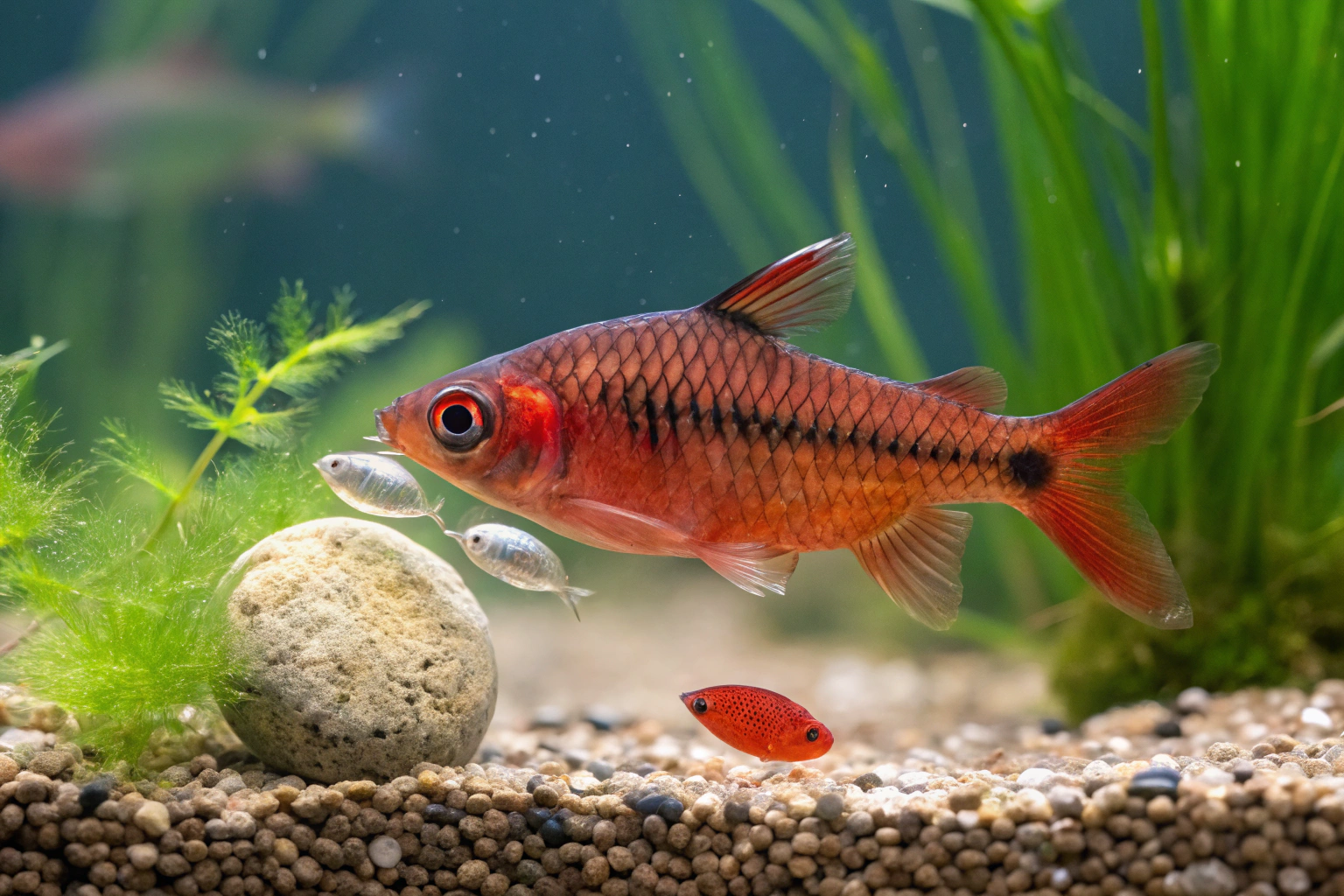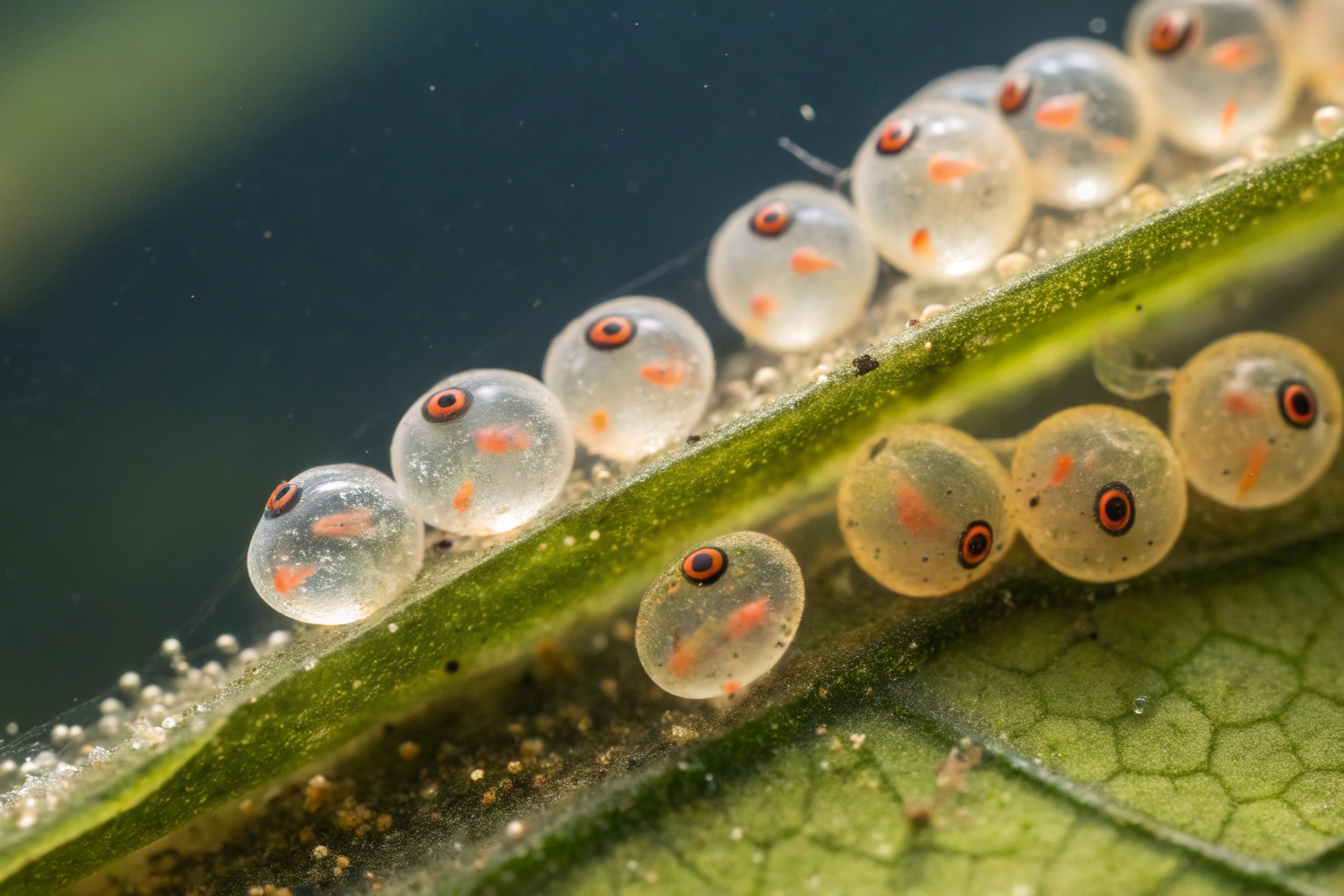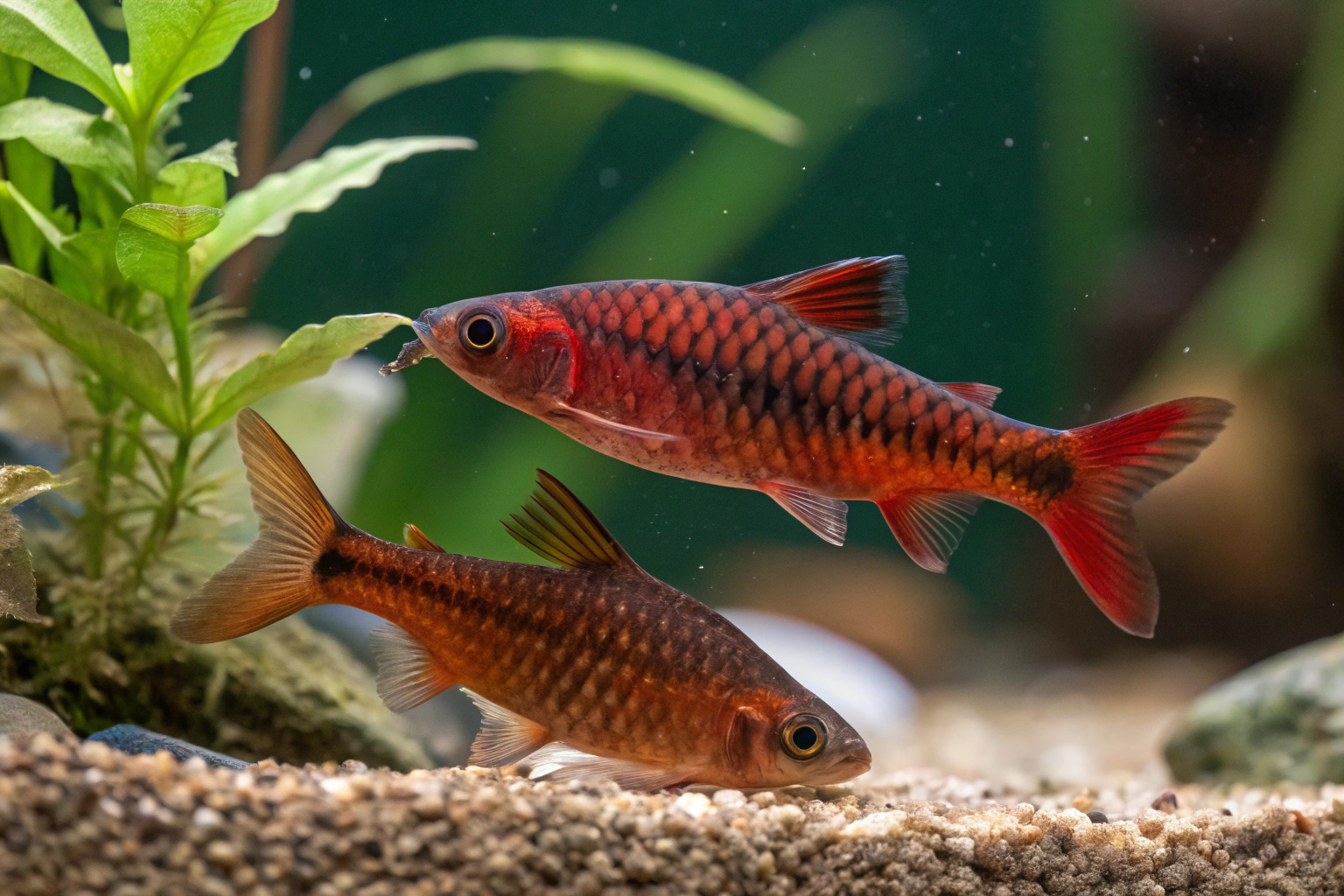How Long Does It Take for Cherry Barb Fish to Breed and Lay Eggs? Complete Breeding Timeline
This post may contain affiliate links.
Cherry Barb fish breeding represents one of the most rewarding experiences for aquarium enthusiasts, but understanding the precise timeline from conditioning to egg-laying can make the difference between success and disappointment. The complete Cherry Barb breeding cycle typically takes 2-4 weeks from initial conditioning to egg deposition, though several factors influence this timeframe significantly.
Most aquarists wonder about the exact timing when they notice their Cherry Barbs displaying breeding behaviors. The answer involves multiple phases: conditioning period (7-14 days), courtship behaviors (2-5 days), and the actual spawning event (6-12 hours). Understanding each phase helps breeders optimize conditions and timing for maximum success rates.

The Cherry Barb Breeding Timeline: Phase by Phase
The Cherry Barb breeding process follows a predictable pattern that experienced breeders can anticipate and manage. Initial conditioning begins when mature adults (6+ months old) are separated and fed high-protein diets to trigger reproductive readiness. This conditioning phase typically requires 7-14 days of intensive feeding with live or frozen foods like bloodworms, brine shrimp, and daphnia.
During conditioning, visual changes become apparent in breeding-ready Cherry Barbs. Females develop noticeably rounded bellies as they fill with eggs, while males intensify their red coloration dramatically. The contrast between breeding and non-breeding coloration is striking, with males displaying deep crimson hues that attract females and signal reproductive fitness.
Environmental triggers play crucial roles in timing. Temperature adjustments, water changes with slightly cooler water, and increased feeding frequency simulate natural breeding conditions. Most successful spawns occur 24-48 hours after a significant water change that drops temperature by 2-3 degrees temporarily, mimicking seasonal rainfall patterns in their native habitat.
Pre-Spawning Behaviors and Timeline Indicators
Recognizing pre-spawning behaviors helps predict exact spawning timing within 12-24 hours of egg deposition. Male Cherry Barbs become increasingly territorial, establishing small territories around preferred spawning sites like dense vegetation or spawning mops. This territorial behavior typically begins 2-3 days before actual spawning occurs.
Courtship rituals intensify as spawning approaches. Males perform elaborate displays, swimming in rapid circles around females while flaring their fins and displaying peak coloration. These courtship dances increase in frequency and intensity, often occurring in early morning hours when spawning is most likely to occur.
Female behavior changes significantly during the final 24-48 hours before spawning. They become more responsive to male advances, following males to spawning sites and examining potential egg deposition areas. Understanding fish breeding behavior patterns helps predict optimal timing for breeding attempts.

The Spawning Event: Hour-by-Hour Timeline
Actual Cherry Barb spawning typically occurs in early morning hours, beginning shortly after lights come on or with the first signs of dawn in naturally lit tanks. The entire spawning event usually completes within 2-6 hours, though multiple spawning sessions may occur over 2-3 consecutive days.
The spawning process begins with intensive courtship, followed by the female selecting appropriate spawning sites among fine-leaved plants or spawning materials. Egg release occurs in small batches of 10-50 eggs per release, with females depositing 200-300 total eggs during a complete spawning cycle.
Males immediately fertilize eggs as they’re released, following closely behind females during egg deposition. This synchronized process ensures high fertilization rates when water conditions are optimal. Post-spawning behavior includes immediate egg consumption attempts by both parents, necessitating quick egg removal or parent separation in breeding setups.
Environmental Factors Affecting Breeding Timeline
Water temperature significantly influences Cherry Barb breeding timeline, with optimal spawning occurring at 78-82°F (25.5-27.8°C). Lower temperatures extend conditioning periods, while excessive heat can prevent spawning entirely. Maintaining stable temperatures within the optimal range accelerates the breeding timeline and improves success rates.
Water chemistry parameters affect reproductive readiness timing. Slightly acidic water (pH 6.0-6.5) with soft to moderate hardness (5-12 dGH) promotes faster reproductive conditioning. Understanding aquarium water chemistry helps optimize conditions for predictable breeding timelines.
Lighting cycles influence breeding timing, with consistent 12-14 hour photoperiods promoting regular reproductive cycles. Sudden lighting changes can disrupt breeding timelines, while gradual adjustments simulate natural seasonal changes that trigger spawning behaviors.

Factors That Can Delay or Accelerate Breeding
Nutrition quality directly impacts breeding timeline speed. High-protein foods rich in carotenoids accelerate conditioning, while poor-quality diets extend preparation periods significantly. Live foods produce faster results than frozen alternatives, though both work effectively when fed consistently.
Tank population density affects breeding timeline through stress levels. Overcrowded conditions delay reproductive readiness, while appropriate stocking levels with compatible tank mates promote faster breeding cycles. Stress from aggressive tank mates or inappropriate companions can postpone breeding for weeks or months.
Age and health status of breeding pairs influence timeline predictability. Young adults (6-12 months) typically breed faster than older fish, while health issues can delay or prevent successful reproduction entirely. Selecting prime breeding stock from quality fish suppliers ensures optimal breeding timeline performance.
Breeding Setup Optimization for Faster Results
Dedicated breeding tank setup significantly improves timeline consistency and success rates. A separate 10-20 gallon breeding tank with optimal conditions allows precise environmental control without interference from community tank variables. This controlled environment typically reduces conditioning time by 3-5 days compared to community tank breeding attempts.
Spawning substrate selection affects both timeline and success rates. Java moss, spawning mops, or fine-leaved plants provide ideal egg deposition sites that females readily accept. The presence of appropriate spawning media can accelerate the final spawning decision by 1-2 days compared to bare tank setups.
Filtration considerations balance water quality maintenance with gentle water movement that doesn’t disturb spawning activities. Sponge filters provide adequate biological filtration while creating minimal current that might interfere with delicate spawning behaviors. Understanding breeding tank filtration helps optimize environmental conditions.

Post-Spawning Timeline and Egg Development
Cherry Barb egg development follows a predictable 24-48 hour timeline from fertilization to hatching, depending on water temperature. At optimal temperatures (80-82°F), eggs typically hatch within 24-30 hours, while cooler conditions extend development time to 36-48 hours.
Fertilized eggs remain transparent to slightly amber-colored, while unfertilized eggs quickly turn white and fuzzy with fungal growth. Removing unfertilized eggs within 12 hours prevents fungal spread to healthy developing embryos. This critical timing requires careful monitoring during the first day post-spawning.
Fry development progresses rapidly once hatching occurs. Newly hatched fry absorb their yolk sacs for 2-3 days before requiring first feeding with infusoria or commercial fry foods. Understanding fry care requirements ensures successful completion of the breeding cycle.
Troubleshooting Common Timeline Issues
Delayed spawning often results from suboptimal conditioning or environmental factors. If spawning doesn’t occur within 3 weeks of conditioning, reassess water parameters, feeding regimen, and potential stress factors. Sometimes starting the conditioning process over with fresh environmental triggers produces better results.
Repeated failed spawning attempts may indicate compatibility issues between selected breeding pairs. Not all Cherry Barb pairs bond successfully, and trying different combinations often resolves persistent breeding failures. Maintaining multiple potential breeding pairs provides backup options when primary pairs don’t perform as expected.
Seasonal variations can affect breeding timeline consistency, with some aquarists reporting faster breeding during spring and summer months despite controlled indoor conditions. These natural rhythms may persist in captive fish, requiring patience during less optimal breeding periods.
Maximizing Breeding Success Through Timeline Management
Successful Cherry Barb breeding requires precise timing coordination between conditioning, environmental triggers, and spawning setup preparation. Planning breeding attempts during periods when consistent monitoring is possible improves success rates significantly, as spawning events require immediate response for optimal egg survival.
Record keeping helps identify patterns in individual breeding pairs’ timeline preferences. Some pairs consistently spawn faster or slower than average, and understanding these individual variations allows better timeline prediction for future breeding attempts. Detailed breeding logs become valuable references for optimizing future breeding cycles.
Temperature cycling techniques can help synchronize multiple breeding pairs for simultaneous spawning events. This approach allows efficient use of breeding equipment and maximizes fry production when space and resources are limited. Understanding advanced breeding techniques provides additional timeline control options.

Conclusion: Mastering Cherry Barb Breeding Timeline
Cherry Barb breeding timeline success depends on understanding and managing multiple interconnected factors that influence reproductive readiness and spawning timing. The typical 2-4 week timeline from conditioning to egg-laying provides a framework, but individual variations require careful observation and adjustment of techniques.
Successful breeders develop intuition for timing through experience with multiple breeding cycles. Each successful spawn provides valuable data for refining techniques and improving timeline predictability. The investment in understanding Cherry Barb breeding timeline pays dividends in consistent reproduction success and healthy fry production.
Whether breeding for personal enjoyment or commercial purposes, mastering Cherry Barb breeding timeline management opens doors to one of freshwater aquaculture’s most rewarding specialties. The combination of relatively easy care requirements and predictable breeding patterns makes Cherry Barbs excellent subjects for developing advanced aquarium breeding skills that transfer to more challenging species.
